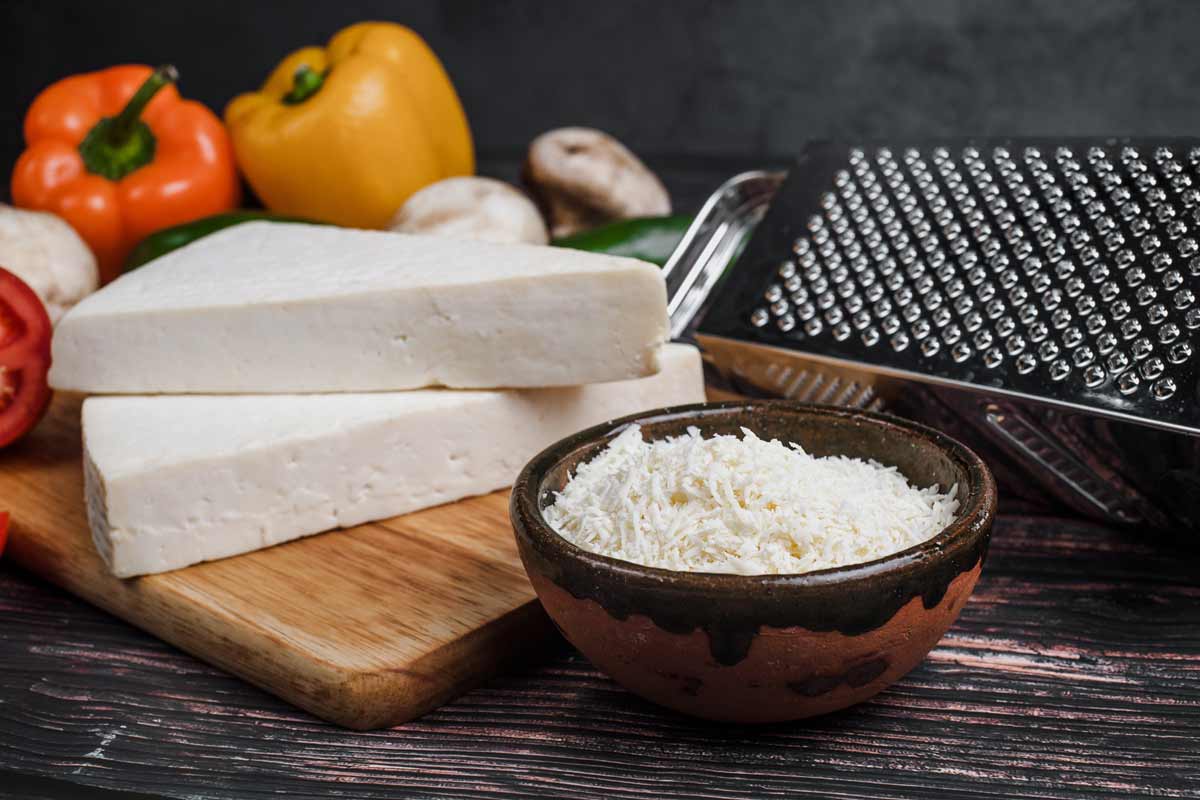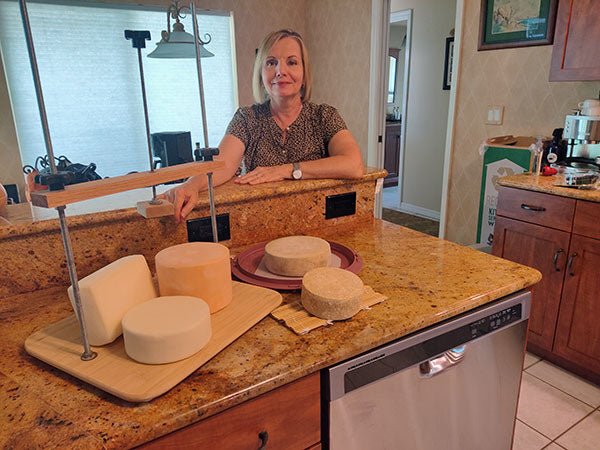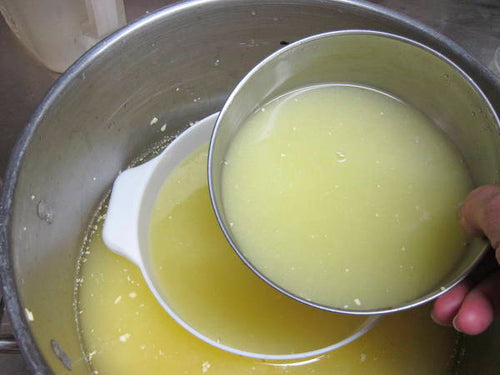 Lately, it seems like every recipe I see online and feel like making has Cotija in it. The corn dishes, in particular, appeal to me.*
Lately, it seems like every recipe I see online and feel like making has Cotija in it. The corn dishes, in particular, appeal to me.*
If I make the crumbly, salty cheese now, it will be ready for corn season here in New England. The question is – what recipe to use?
It’s been 12 years since we last posted a recipe for Cotija (click here). Esperanza Pallano contributed it and, at that time (2011), it was the only Cotija recipe we could find on the web.
Now, surprisingly, there aren’t that many more. There are a few videos, including Gavin Webber’s (click here) and there is a recipe with great pictures at Rebooted Mom. The easiest to follow is probably the one at eHow. They are all pretty much the same recipe.
Esperanza’s account was her first time making Cotija and, when it was done, she said it was a little too salty (she added 1/2 cup to the curds). There is much less salt in the recipe below.
Timeline: This recipe will require your attention (off and on) for the first 3 1/2 – 4 hours, with a lot of that time spent waiting. Then, it will be in the press for 12 hours. If you start making this cheese in the early morning, you will be able to take it out of the press and put it in the brine before bed. If you start making it in late afternoon, you will be able to press it overnight and put it in the brine the following morning.
Beginners: This is not really a beginner cheese but you can make it if you know how to check the curds for a clean break and how to cut the curds. You will need a cheese press or some way to press the cheese to 15 pounds. You will need to use dechlorinated water to dissolve your rennet and your calcium chloride. (You can use spring water, distilled water or filtered water or you can boil tap water for 20 minutes and cool to room temp.). Check the aging procedure to make sure you can provide the proper temp and humidity.
Cotija (Mexican Parmesan)
Equipment needed:
Cheese mold for 2 gallons of milk
Cheese press or hand weights that total 15 pounds
Non-reactive pot (like stainless steel) that holds 2 gallons
Curd knife to cut the curd
Colander or fine mesh strainer
Cheese mat for drying the cheese
Cheesecloth
Container for aging the cheese
Cheese wrap if you are not vacuum sealing.
Ingredients:
For the cheese:
2 gallons raw milk (preferably). If you use pasteurized, add 1/2 tsp calcium chloride diluted in 1/4 cup dechlorinated water before adding the rennet. Stir in well.
1/4 tsp mesophilic culture
1/4 tsp thermophilic culture
1/4 tsp organic liquid vegetable rennet diluted in 1/4 cup dechlorinated cool water. (You can use 1/4 tsp of any extra strength rennet.) Or, 1/2 tsp of animal rennet. Or, 1/2 rennet tablet
1 cup dechlorinated water)
1/8 cup cheese salt or sea salt or any non-iodized salt
For the brine solution:
1.5 cups sea salt or non-iodized salt
1 quart warm water
Directions:
As always, make sure your pot, spoon, knife, mold and cheesecloth are sterilized.
With the heat on low, gently bring the milk to 100F/38C.
Turn the heat off. Sprinkle your packet of mesophilic culture on the surface of the milk. Then sprinkle your packet of thermophilic culture on the milk.
Cover the pot and allow the cultures to hydrate on the surface for 5 minutes.
Stir the milk with an up and down motion for 30 – 60 seconds.
Check the temperature of the milk. You want it to remain at 100F for the next 2 hours. It is easy to do this by putting the pot in a pan of hot water. It is even easier if you use a sous vide.
Place the lid on the pot and let it rest for 30 minutes at 100F/38C.
Remove the lid and, if you are using pasteurized milk, stir the diluted calcium chloride into it.
Add the rennet diluted in cool water. Stir vigorously with an up and down motion for 30 seconds – 1 minute (no more).
Check the temperature to be sure you are maintaining 100F/38C.
Cover the pot again. Allow the pot to sit, undisturbed, for 90 minutes. The milk should remain at 100F/38C during this time.
Check for the clean break. If the milk isn’t ready, let it set until it is.
Cut the curd into 1/2 inch squares.
Cover the pot and let the curds heal for 10 minutes.
Stir the curds gently in an up and down motion while heating the curds to 105F/41C. This should be slow enough to take 1o minutes, more or less. As you stir, the curds will shrink in size. Your goal, when stirring, is to keep the curds from matting together.
When the milk is up to temp, take the pot off the heat. Cover it and let it set for 10 minutes. The curds will sink to the bottom of the pot.
Then, carefully drain off the whey. (To do this, place cheesecloth over a colander, and the colander over a large clean pot. Slowly pour the curds over the colander, allowing the cheesecloth/colander to catch the curds.)
Allow the curds to drain for 15 minutes. Leave them in the colander. (You can save the whey for baking, feeding your pets, etc.)
While the cheese is still in the colander, add the salt. Work it through the curds thoroughly with your hands or a spoon. While you are doing this, the salt will assist the curds in releasing whey.
Place the curds and cheesecloth into the mold.
Press at 15 lbs/6 kg of pressure for 30 minutes.
Carefully unwrap the curds, flip over, re-wrap, and press again at 15 pounds of pressure for approximately 12 hours.
Brining:
Prepare the brine solution with warm water and then bring it to room temp.
Remove the cheese from the press. Carefully unwrap the cheesecloth. Place the cheese in the brine for 24 hours, flipping the cheese at the 12 hour mark. Save the brine.
Air dry for six hours on a cheese mat, allowing the air to circulate around the cheese.
Put the cheese in a container to hold the humidity.
Age for 2 weeks at 55F (13C) at 80-85% humidity, turning once daily.
Use the brine to wipe off any mold that might start during that time.
After 2 weeks, vacuum seal the cheese or wrap it (preferably with cheese wrap) and allow to age for 4 additional weeks in the fridge (38F/3C).
The longer you age Cotija, the more it takes on the resemblance of parmesan cheese. If you age it for a shorter period, it is a very soft, crumbly cheese.
*A few recipes:
Grilled Corn Salad with Lime, Red Chili and Cotija
Healthy Cotija + Corn Guacamole
Chive and Cotija Cheese Biscuits
Avocado Toast With Chipotle Mayo, Cotija Cheese, Cilantro, and Lime













































































































































